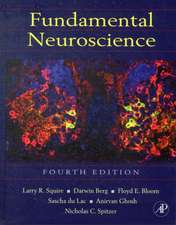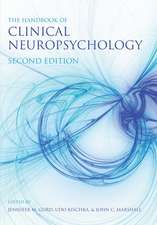Müller Cells in the Healthy and Diseased Retina
Autor Andreas Reichenbach, Andreas Bringmannen Limba Engleză Paperback – 30 noi 2014
| Toate formatele și edițiile | Preț | Express |
|---|---|---|
| Paperback (1) | 1551.90 lei 6-8 săpt. | |
| Springer – 30 noi 2014 | 1551.90 lei 6-8 săpt. | |
| Hardback (1) | 1559.97 lei 6-8 săpt. | |
| Springer – 18 mar 2010 | 1559.97 lei 6-8 săpt. |
Preț: 1551.90 lei
Preț vechi: 1892.56 lei
-18% Nou
Puncte Express: 2328
Preț estimativ în valută:
296.97€ • 317.55$ • 247.60£
296.97€ • 317.55$ • 247.60£
Carte tipărită la comandă
Livrare economică 17 aprilie-01 mai
Preluare comenzi: 021 569.72.76
Specificații
ISBN-13: 9781489985026
ISBN-10: 1489985026
Pagini: 432
Ilustrații: XIV, 417 p.
Dimensiuni: 155 x 235 x 23 mm
Greutate: 0.66 kg
Ediția:2010
Editura: Springer
Colecția Springer
Locul publicării:New York, NY, United States
ISBN-10: 1489985026
Pagini: 432
Ilustrații: XIV, 417 p.
Dimensiuni: 155 x 235 x 23 mm
Greutate: 0.66 kg
Ediția:2010
Editura: Springer
Colecția Springer
Locul publicării:New York, NY, United States
Public țintă
ResearchDescriere
Müller glial cells ensheath all retinal neurons in vertebrate retinae. There are a multitude of functional interactions between neurons and Müller cells, including delivery of the light stimuli to the photoreceptor cells in the inverted vertebrate retina, a 'metabolic symbiosis' with the neurons, and the processing of visual information. Müller cells are also responsible for the maintenance of the homeostasis of the retinal extracellular milieu (ions, water, neuro¬transmitter molecules, and pH). In vascularized retinae, Müller cells may also be involved in the control of angiogenesis, and the regulation of retinal blood flow. Virtually every disease of the retina is associated with a reactive Müller cell gliosis which, on the one hand, supports the survival of retinal neurons but, on the other hand, may accelerate the progress of neuronal degeneration:
Müller cells protect neurons via a release of neurotrophic factors. However, gliotic Müller cells display a dysregulation of various neuron-supportive functions. This contributes to a disturbance of retinal glutamate metabolism and ion homeostasis, and causes the development of retinal edema and neuronal cell death. Moreover, there are diseases evoking a primary Müller cell insufficiency, such as hepatic retinopathy and certain forms of glaucoma. Any impairment of supportive functions of Müller cells, primary or secondary, must cause and/or aggravate a dysfunction and loss of neurons, by increasing the susceptibility of neurons to stressful stimuli in the diseased retina.
Müller cells may be used in the future for novel therapeutic strategies to protect neurons against apoptosis (i.e. somatic gene therapy), or to differentiate retinal neurons from Müller/stem cells. Meanwhile, a proper understanding of the gliotic responses of Müller cells in the diseased retina, and of their protective vs. detrimental effects, is essential for the development of efficient therapeutic strategies that use and stimulate the neuron-supportive/-protective - and prevent the destructive - mechanisms of gliosis.
Müller cells protect neurons via a release of neurotrophic factors. However, gliotic Müller cells display a dysregulation of various neuron-supportive functions. This contributes to a disturbance of retinal glutamate metabolism and ion homeostasis, and causes the development of retinal edema and neuronal cell death. Moreover, there are diseases evoking a primary Müller cell insufficiency, such as hepatic retinopathy and certain forms of glaucoma. Any impairment of supportive functions of Müller cells, primary or secondary, must cause and/or aggravate a dysfunction and loss of neurons, by increasing the susceptibility of neurons to stressful stimuli in the diseased retina.
Müller cells may be used in the future for novel therapeutic strategies to protect neurons against apoptosis (i.e. somatic gene therapy), or to differentiate retinal neurons from Müller/stem cells. Meanwhile, a proper understanding of the gliotic responses of Müller cells in the diseased retina, and of their protective vs. detrimental effects, is essential for the development of efficient therapeutic strategies that use and stimulate the neuron-supportive/-protective - and prevent the destructive - mechanisms of gliosis.
Cuprins
Müller Cells in the Healthy Retina.- Müller Cells in the Diseased Retina.- Conclusions and Perspectives.
Textul de pe ultima copertă
Müller cells make up just 0.005% of the cells in our central nervous system. They do not belong to the more esteemed family of neuronal cells but to the glia, a family of cells that until recently were seen as mere filling material between the neurons. Now, however, all that has changed. Sharing the insights of more than a quarter century of research into Müller cells, Drs. Andreas Reichenbach and Andreas Bringmann of Leipzig University make a compelling case for the central role Müller cells play.
Everyone agrees that the eye is a very special and versatile sense organ, yet it has turned out in recent years that Müller cells are peculiar and multipotent glial cells. In the retina of most vertebrates and even of many mammals, Müller cells are the only type of (macro-) glial cells; thus, they are responsible for a wealth of neuron-supportive functions that, in the brain, rely upon a division of labour among astrocytes, oligodendrocytes, and ependymal cells. Even beyond such a role in the central nervous system as "model glia", Müller cells are adapted to several exciting roles in support of vision. They deliver the light stimuli to the photoreceptor cells in the inverted vertebrate retina, aid the processing of visual information, and are responsible for the homeostatic maintenance of the retinal extracellular milieu.
In Müller Cells in the Healthy and Diseased Retina, aimed not just at neurobiologists but at anyone concerned with retinal degeneration, every angle of Müller cells is covered, from an introduction to their basic properties, through their roles as ‘light cables’ and ‘shock absorbers’, to the part they play in diseases and disorders of the eye. Once these have all been covered in detail, the authors move on to discuss the future direction of research into these small but potent cellular phenomena. About the Authors
Dr. Andreas Reichenbach was born in 1950 in Leipzig, Germany. He studied medicine and specialized as a physiologist, working on the mammalian retina. Since 1984, he has focused his efforts – and those of a growing number of fellows in his team – on Müller cell research. He has held a professorship at Leipzig University since 1994.
After studying biology, Dr. Andreas Bringmann (* 1960) worked in the field of systemic neurophysiology until he was inspired in 1996 by Andreas Reichenbach to research the most interesting cell, the Müller cell. He is now in the Department of Ophthalmology of the University of Leipzig where he is the head of the Basic Research Laboratory.
Everyone agrees that the eye is a very special and versatile sense organ, yet it has turned out in recent years that Müller cells are peculiar and multipotent glial cells. In the retina of most vertebrates and even of many mammals, Müller cells are the only type of (macro-) glial cells; thus, they are responsible for a wealth of neuron-supportive functions that, in the brain, rely upon a division of labour among astrocytes, oligodendrocytes, and ependymal cells. Even beyond such a role in the central nervous system as "model glia", Müller cells are adapted to several exciting roles in support of vision. They deliver the light stimuli to the photoreceptor cells in the inverted vertebrate retina, aid the processing of visual information, and are responsible for the homeostatic maintenance of the retinal extracellular milieu.
In Müller Cells in the Healthy and Diseased Retina, aimed not just at neurobiologists but at anyone concerned with retinal degeneration, every angle of Müller cells is covered, from an introduction to their basic properties, through their roles as ‘light cables’ and ‘shock absorbers’, to the part they play in diseases and disorders of the eye. Once these have all been covered in detail, the authors move on to discuss the future direction of research into these small but potent cellular phenomena. About the Authors
Dr. Andreas Reichenbach was born in 1950 in Leipzig, Germany. He studied medicine and specialized as a physiologist, working on the mammalian retina. Since 1984, he has focused his efforts – and those of a growing number of fellows in his team – on Müller cell research. He has held a professorship at Leipzig University since 1994.
After studying biology, Dr. Andreas Bringmann (* 1960) worked in the field of systemic neurophysiology until he was inspired in 1996 by Andreas Reichenbach to research the most interesting cell, the Müller cell. He is now in the Department of Ophthalmology of the University of Leipzig where he is the head of the Basic Research Laboratory.
Caracteristici
Provides a comprehensive review of Müller glial cells in the retina
Contains color images
Will be of interest to neuroscientists as well as ophthalmologists
Includes supplementary material: sn.pub/extras
Contains color images
Will be of interest to neuroscientists as well as ophthalmologists
Includes supplementary material: sn.pub/extras
















